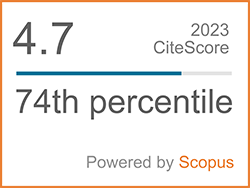Effect of Carbon Fiber and Graphite Powder on Resistivity of Cement-based Sensor under Compression
Abstract
Structural health monitoring currently becomes an important part in the maintenance of concrete structures. Thus, using of sensors to monitor the structural behavior is necessary. Cement-based sensors have been developed recently to be embeddable in structures and to be implemented by measuring the change in their resistivity. In this research, the electrical resistivity and compressive strength of the cement-based sensors with the addition of carbon fiber (2% and 4% by volume fraction) and graphite powder (2%, 4%, and 10% by weight of cement) were studied. Three water to binder ratios (w/b) that are 0.3, 0.4 and 0.5 were varied. For 28 days after demolding, the resistivity of the non-load-bearing sensors was monitored to determine the influence of their maturity. At the age of 28 days, their compressive strength was evaluated. Subsequently, the fractional change in resistivity (FCR) of the sensors was measured under a set of compressive loading, which comprised of three cycles of loading; first loading to the strain of 0.0025, then to 0.005 and 0.01. From the test results, it is showed that the carbon fiber was more favorable than the graphite powder. Although the addition of graphite powder could reduce the resistivity, it dropped the compressive strength and highly fluctuated the resistivity results of the cement-based sensors. In term of the piezoresistivity, all of the sensors when loaded provided good responses only when the compressive strain was less than 0.005.
Keywords
Refbacks
- There are currently no refbacks.









